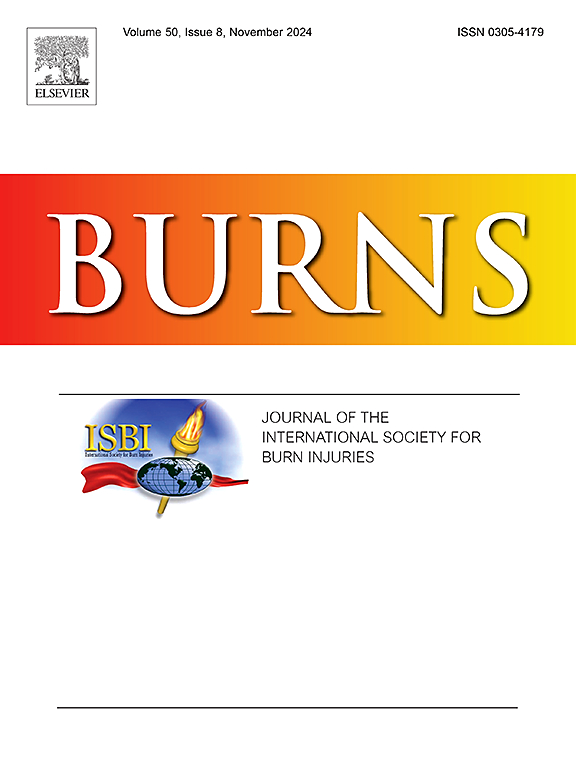Investigation into nurses’ emotion regulation while causing pain to adult patients during burns dressing changes: a qualitative study
IF 3.2
3区 医学
Q2 CRITICAL CARE MEDICINE
引用次数: 0
Abstract
Background
Burns can cause patients significant pain at the time of injury and during subsequent treatment. Other people’s pain often elicits empathic responses in observers. However, effective emotion regulation strategies are needed to manage personal distress, which may otherwise inhibit helping behaviour.
Methods
This study used an interpretative qualitative approach to conduct semi-structured interviews with burns nurses. Interviews explored emotion regulation strategies used by nurses whilst causing pain to adult patients during burns dressing changes. Transcripts were analysed using Braun and Clarke’s six stages of thematic analysis.
Results
Eight burns nurses participated in the interviews. Thematic analysis developed five themes: Emotions get in the way of being a good nurse; Pain’s an inevitable and justifiable part of treatment and healing; If I’m not made aware of the pain, maybe there is no pain; The pain’s due to other factors, not my actions; and Sometimes it’s too much.
Conclusion
Burns nurses’ attempts at regulating their emotions were influenced by their beliefs about what makes a ‘good’ nurse. Gross’s model of emotion regulation provides a useful framework for understanding these strategies, but further research is needed into the helpfulness thereof for nurses and patients.
成人烧伤换药过程中护士致痛情绪调节的定性研究。
背景:烧伤可引起患者在受伤时和随后的治疗过程中明显的疼痛。别人的痛苦常常会引起旁观者的共鸣。然而,需要有效的情绪调节策略来管理个人痛苦,否则可能会抑制帮助行为。方法:本研究采用解释性定性方法对烧伤护士进行半结构化访谈。访谈探讨了护士在烧伤换药过程中对成年患者造成疼痛时使用的情绪调节策略。使用Braun和Clarke的六阶段主题分析来分析抄本。结果:8名烧伤护理人员参与了访谈。专题分析得出五个主题:情绪阻碍了成为一名好护士;疼痛是治疗和康复过程中不可避免的,也是合理的一部分;如果我没有意识到痛苦,也许就没有痛苦;疼痛是其他因素造成的,不是我的行为;有时又太多了。结论:烧伤护士试图调节自己的情绪受到他们对“好”护士的信念的影响。格罗斯的情绪调节模型为理解这些策略提供了一个有用的框架,但需要进一步研究它对护士和病人的帮助。
本文章由计算机程序翻译,如有差异,请以英文原文为准。
求助全文
约1分钟内获得全文
求助全文
来源期刊

Burns
医学-皮肤病学
CiteScore
4.50
自引率
18.50%
发文量
304
审稿时长
72 days
期刊介绍:
Burns aims to foster the exchange of information among all engaged in preventing and treating the effects of burns. The journal focuses on clinical, scientific and social aspects of these injuries and covers the prevention of the injury, the epidemiology of such injuries and all aspects of treatment including development of new techniques and technologies and verification of existing ones. Regular features include clinical and scientific papers, state of the art reviews and descriptions of burn-care in practice.
Topics covered by Burns include: the effects of smoke on man and animals, their tissues and cells; the responses to and treatment of patients and animals with chemical injuries to the skin; the biological and clinical effects of cold injuries; surgical techniques which are, or may be relevant to the treatment of burned patients during the acute or reconstructive phase following injury; well controlled laboratory studies of the effectiveness of anti-microbial agents on infection and new materials on scarring and healing; inflammatory responses to injury, effectiveness of related agents and other compounds used to modify the physiological and cellular responses to the injury; experimental studies of burns and the outcome of burn wound healing; regenerative medicine concerning the skin.
 求助内容:
求助内容: 应助结果提醒方式:
应助结果提醒方式:


